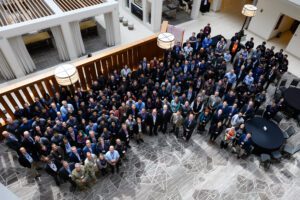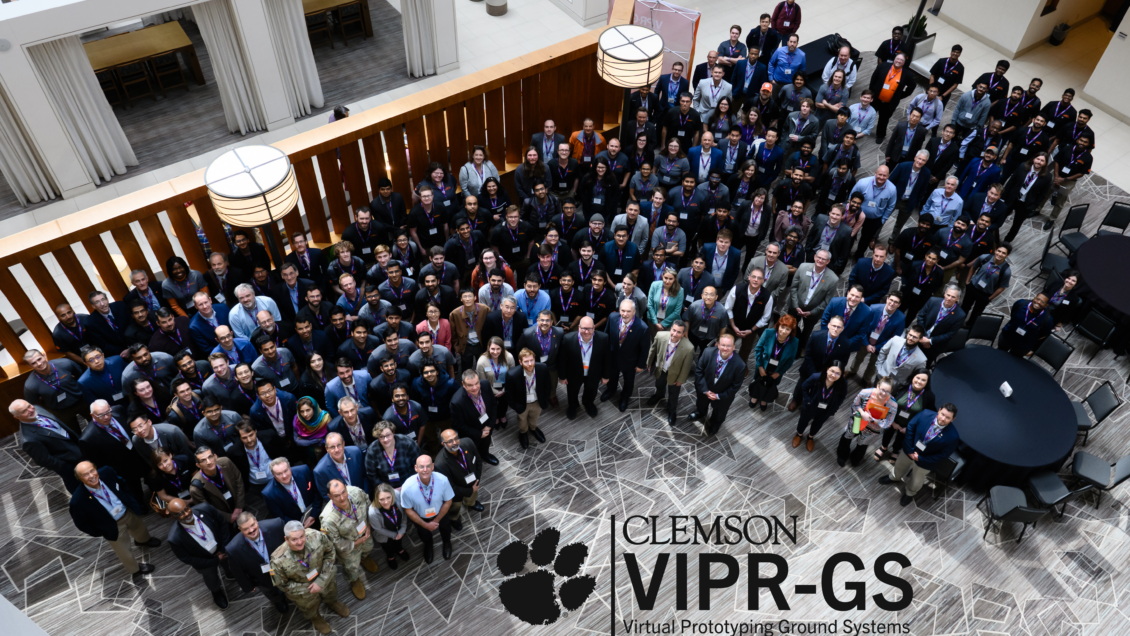The future of digital engineering and the importance of industry partnerships took center stage as more than 330 leaders from Clemson University, the U.S. Army DEVCOM and industry gathered in Greenville for two days of research presentations, demonstrations and panel discussions.

“The future of this nation’s development of vehicles systems depends on our implementation of digital engineering approaches,” said David Gorsich, the chief scientist for the DEVCOM Ground Vehicle Systems Center. “These approaches make the design and development of our systems faster, more efficient and cost effective and reduce risk. Based on the pressures of global competition, there is no other way.”
The event was part of an annual review of the VIPR-GS Research Center, a partnership between Clemson and the DEVCOM Ground Vehicle Systems Center that is now in its fifth year. More than 80 faculty members and about 120 graduate students are supported by VIPR-GS, which is an acronym for Virtual Prototyping of Autonomy-Enabled Ground Systems.
Gorsich said the event was fantastic. He gave the keynote address on the first day and was peppered with questions from industry, faculty and student leaders.
“All the questions in digital engineering were right on,” he said later. “Sharing and talking about what those challenges are and how we can move forward is really valuable– and it is not just with faculty, it is with industry.”
“Outstanding” is how the event was described by Zoran Filipi, the founding director of both the VIPR-GS Research Center and Clemson’s School of Mechanical and Automotive Engineering. The event included a large contingent from what he called Clemson’s “customer,” the DEVCOM Ground Vehicle Systems Center, and about 75 industry leaders.

“We want to expose what we do here to the world,” Filipi said. “The research we do can be very important to industry, too, so this year we are making this big push to engage in the biggest way. The scale of this event is unprecedented. Many other universities have excellent research centers with a particular focus, but in our case, we cover all the key areas for transformation of commercial and military fleets.”
The VIPR-GS Research Center’s focus is on creating advanced tools and methods for testing vehicles quickly and affordably through virtual prototyping. By accelerating design and development processes, the center aims to get next-generation vehicles on the road and in the field faster than standard prototyping, while creating the future workforce.
For Clemson, the VIPR-GS Research Center spans 10 departments covering a wide range of disciplines from computer engineering to civil engineering in the University’s College of Engineering, Computing and Applied Sciences.
“The college is a powerhouse for engineering in the Southeast, and VIPR-GS pulls all those disciplines together,” said Robert Prucka, the deputy director of VIPR-GS and the Kulwicki Endowed Chair of Automotive Engineering. “The college has a culture of collaboration and focuses on research that really matters. We have partnerships with industry, and that is important to us because it keeps our research grounded in reality.”
Some researchers in the College of Science are also involved.
VIPR-GS is based at the Clemson University International Center for Automotive Research (CU-ICAR) in Greenville. Significant additional facilities for faculty and students are also on the main campus.

Angie Leidinger, Clemson’s senior vice president for external affairs and senior advisor to the Board of Trustees, told a nearly packed conference room that CU-ICAR is a unique campus that brings together academics, testing facilities, students and outside partners to collaborate in a way that wouldn’t be possible on the main campus about 45 minutes away.
“It is truly the epitome of a public-private partnership,” Leidinger said. “There was legislation that was passed that allowed significant state investment. There is investment by industry partners, and there is investment by the community.”
In a real-time demonstration of how Clemson works with partners, VIPR-GS Associate Director and Automotive Engineering Professor Johnell Brooks led a “Voice of the Soldier” panel discussion.
The panelists, including a current and retired major general in the South Carolina National Guard, explored the unique challenges faced by soldiers operating military vehicles, ranging from swiftly flowing floodwater to how much force it takes to open hatches.
“Everytime I spend time with soldiers I learn something new and develop a deeper perspective,” Brooks said. “I am grateful for giving us the opportunity to bring that knowledge back to our students.”
The VIPR-GS Research Center aims to support military modernization by developing technologies for off-road vehicle autonomy and efficient energy use, aligning with the U.S. Army’s Next Generation Combat Vehicles program.

Work spans three main areas: off-road vehicle autonomy, vehicle propulsion and digital engineering. While presentations and demonstrations dove into all three, the challenges and advantages of digital engineering emerged as one of the event’s biggest topics.
Panelists said definitions of digital engineering can vary. Gorsich offered one from the Department of Defense’s 2018 digital engineering strategy: “An integrated digital approach that uses authoritative sources of system data and modules as a continuum across disciplines to support lifecycle activities from concept through disposal.”
“There are a lot of advantages in digital engineering,” Gorsich said. “Key in all of it is being able to do things more efficiently. Instead of printing out PowerPoint charts and trying to go back to the model, it is more efficient to just work directly from the model. It is thinking about it differently.”
Leaders filled a large conference room on March 5 at the Embassy Suites on Verdae Boulevard to launch the event, and it moved to CU-ICAR about a mile away on March 6. Toward the end, thoughts turned toward what is next for the VIPR-GS Research Center.
“It is building upon what we’ve already done here and moving in the direction where we work on very relevant challenges to the Army and also bringing industry and partnerships with industry because that is key to transitioning,” Gorsich said.
Filipi said a proposal to extend funding for VIPR-GS for two years is in the works and could include new topics, such as human-machine integrated formations.
Get in touch and we will connect you with the author or another expert.
Or email us at news@clemson.edu

